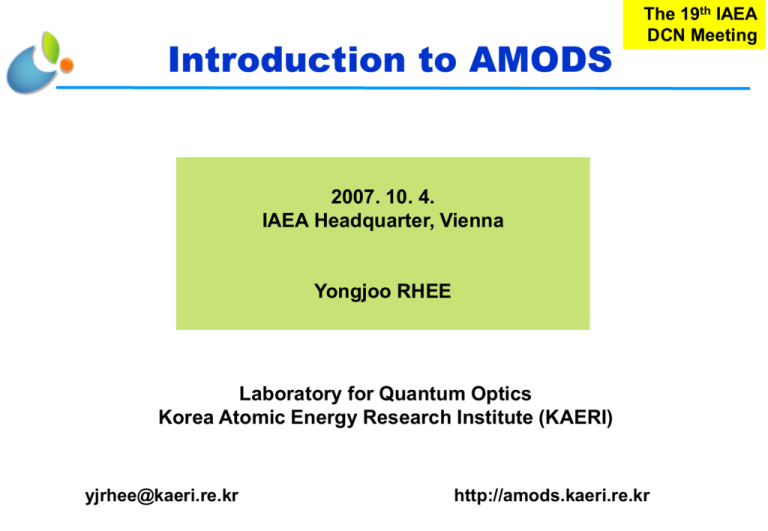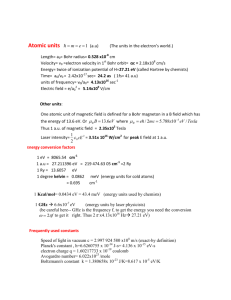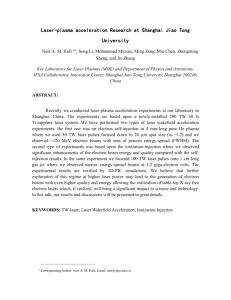Rhee - IAEA Atomic and Molecular Data Unit
advertisement

Introduction to AMODS The 19th IAEA 1 DCN Meeting 2007. 10. 4. IAEA Headquarter, Vienna Yongjoo RHEE Laboratory for Quantum Optics Korea Atomic Energy Research Institute (KAERI) yjrhee@kaeri.re.kr http://amods.kaeri.re.kr 2 CONTENTS 1. Introduction to Laboratory for Quantum Optics, KAERI 2. High resolution atomic spectroscopy - auto-ionization level, hyperfine splitting, isotope shift - spectroscopy apparatus - theoretical calculation (Isotope shift of Sm) 3. Atomic processes in a fusion plasma (NIST) - electron impact ionization cross sections of W/Mo Th Exp Th 4. Emission spectra of highly charged ions - calculation of Xe10+ spectra (NIFS) - spectra of highly charged W ions 5. Nuclear fusion - small scale laser fusion - neutron yield Exp 6. AMODS database Th 7. Summary 1 Based on the “Atomic Physics”, atomic spectroscopy and nuclear fusion research are pursued at Lab. for Quantum Optics, KAERI. Density matrix STIRAP isotope shift hyperfine structure autoionization Atomic Spectroscopy 3 Laser-induced plasma Atomic Physics Fusion Research (MFE, IFE) - Korea (KAERI, NFRC, KAIST, GIST) - Japan (NIFS, ILE) - China (SIOM, CAEP, IOP) Laser Propagation Population Dynamics AMODS Relativistic structure calculation Electron impact ionization Radiative transition of HCI 2 High resolution laser spectroscopy facility has been established to measure the atomic parameters such as IS, HFS, AI levels. Nd:YAG Laser Freq stab. Dye Laser 1 Dye Laser 2 Wavemeter SLM SLM Dye Laser 3 Lock-in Amplifier MCP TOF Pulsed 3-step MPI lasers PD1 DPSS Laser PD2 Short Pulse Laser Heat Pipe Oven SH Generator CW narrow-band laser system Digital Oscilloscope Atomizer Broad-band short pulse lasers CW Diode Laser Multichannel Analyzer Hollow Cathode Lamp Powermeter Atomic spectroscopy for rare earth elements (57-71) La, Ce, Pr, Nd, Pm, Sm, Eu, Gd, Tb, Dy, Ho, Er, Tm, Yb, Lu PD3 PD4 Boxcar Control Computer Periodic Table of Elements 4 Electronic energy level shifts are due to the interaction of electron with nuclei (proton and neutron) as well as other electrons. Isotope Shifts : Shifts of electronic energy levels due to different number of neutrons in isotopes even with the same number of protons and electrons Hyperfine structure : splitting of electronic energy level due to proton spin – electron orbital, proton spin – electron spin interaction. Autoionixation level: bound state above the ionization threshhold energy 5 Energy level structure should be known precisely for multi-step ionization processes. Multi-step excitation/ionization of Yb (Z=70) G = 14 cm-1 ionization potential. 170 171 168 582.782nm s = 7.8 x 10-15 cm2 t=1.2 ms 171 J=3 1.5 GHz J=2 4.0 GHz 4.3 GHz 581.067nm d=4.3 x 10-31 C m t =840 ns J=1 170 555.648nm 171 168 d=2.7 x 10-30 C m ground level 173 J=0 1.3 GHz 1.4 GHz 0.15 GHz 6 Detection of fluorescence characteristics can give an information on the ionization efficiency. Nd:YAG laser w3 Dye laser 1 Dye laser 2 Dye laser 3 Gd ionizing laser w2 fluorescence w1 Wavemeter Monochromator Computer Lens PMT Lens Deflection plate Drift tube Oscilloscope Optical fiber Acceleration grids Gd atomic beam Micro channel plate Time-of-flight mass spectrometer Photoionization efficiency from the second excitation level to the continuum state can be estimated by observing the decrease of fluorescence signal from the second level. 7 8 Isotope shift can be analyzed by “King” plot method to investigate the effect due to mass and volume separately Doppler-free SAS spectrum Atomic Transition Lines 5d 6s2 4f6 6s 6p 1.4x10 -3 4 Intensity(arb.units) 4f5 7F 399.002 nm 7F 1 672.588 nm 4f6 6s2 7F 5 7F 0 1.2x10 -3 (4f66s2 7F0 4f6 6s 6p 7F1) 152 Sm 154 Sm 1214.8 MHz 15 MHz 1.0x10 -3 147 Sm 148 Sm 8.0x10 -4 144 Sm 150 Sm 6.0x10 -4 2265.6 MHz 1608.8 MHz 2739.5 MHz 4.0x10 -4 144 Sm Modified isotope shifts of transition lines (MHz) 2.0x10 -4 0.0 King plot analysis 0 2000 150-148 148-144 154-152 500 0 -500 154-152 -1000 150-148 -1500 148-144 -2000 152-150 (4f66s2 7F5 4f5 5d6s2 7F4) 3.5x10 -4 Intensity (Arb. Unit) 1000 -2000 -1800 -1600 -1400 -1200 Modified isotope shifts of 598.97nm transition (Reference) (MHz) 8 10 152 Sm 3.0x10 -4 801.6 154 Sm MHz 2.5x10 -4 2.0x10 -4 1.5x10 -4 1799.6 MHz 1.0x10 -4 147 Sm 5.0x10 -5 -2200 4 6 Relative Frequency ( GHz) 399.002 nm 672.588 nm 1500 152-150 -2500 -2400 2 148 Sm 1158.3 MHz 149 Sm 150 Sm 1825.9 MHz 144 Sm 0.0 0 1 2 3 4 5 Frequency Detuning (GHz) 6 7 Isotope shifts of Sm (Z=62) have been measured for various levels and compared with the theoretical calculation using MCDF 4f5 5d 6s2 7F4 28180.95 cm-1 4f5 5d 6s2 7F3 19501.27 cm-1 18948.78 cm-1 18475.28 cm-1 18075.67 cm-1 17830.80 cm-1 17810.85 cm-1 17769.71 cm-1 4f5 5d 6s2 7H3 17190.20 cm-1 4f6 6s2 7FJ 399.00 nm c 580.28 nm b 599.51 nm b 565.99 nm b 562.18 nm b 5 4 3 2 1 0 587.42 nm b 14863.85 cm-1 570.68 nm b 9F 1 562.60 nm b 4f6 6s 6p 7F 1 7H 2 7F 3 7F 0 7F 1 7F 2 591.64 nm b 5d 6s2 5d 6s2 6s 6p 6s 6p 6s 6p 6s 6p 672.59 nm a 4f5 4f5 4f6 4f6 4f6 4f6 3125.46 cm-1 2273.09 cm-1 1489.55 cm-1 811.92 cm-1 292.58 cm-1 0 cm-1 9 Comparison of calculated isotope shifts of neutral Sm atom agrees well with the experimental data. Transition line (nm) 10 MCDF values (Ei/Eref) Classification Experimental values (Ei/Eref) single config. multiple config. 672.588 4f66s2 7F0 4f66s6p 7F1 0.98 0.97 0.97 591.64 4f66s2 7F1 4f66s6p 7F2 1.00 1.02 1.02 562.60 4f66s2 7F0 4f66s6p 7F1 0.19 1.02 1.02 570.68 4f66s2 7F1 4f66s6p 7F0 0.76 1.02 1.02 587.42 4f66s2 7F2 4f66s6p 7F3 1.00 1.03 1.03 562.18 4f66s2 7F1 4f55d6s2 7H2 -1.51 -2.18 -1.35 565.99 4f66s2 7F2 4f55d6s2 7F1 -1.02 -2.19 -1.03 599.51 4f66s2 7F4 4f55d6s2 7H3 -1.34 -2.17 -1.32 580.28 4f66s2 7F4 4f55d6s2 7F3 -1.03 -2.18 -1.03 399.002 4f66s2 7F5 4f55d6s2 7F4 -0.98 -2.22 -1.02 Relativistic MCDF code can calculate atomic structure and transitions. 11 Multi Configuration Dirac-Fock (MCDF) code : Jean-Paul Desclaux (Grenoble, France) Paul Indelicato (University of Paris, France) Yong-Ki Kim (NIST, USA) - ralativistic wave functions - electric and magnetic multipole transition - plane wave Born cross section - angular coefficients, etc Dirac-Fock Equation d κA εAA dr + r - c VA (r) - c Screened Coulomb charge term Radial function X r VA (r) -2c εA,B P (r) c A = d κA εAA QA (r) B =A c - dr r c Exchange term QB (r) XQA (r) + -X -P (r) B PA (r) Lagrange multipliers http://amods.kaeri.re.kr/mcdf/MCDF.html PC version – downloadable from MCDF site Workstation version (2000) 3 Atomic processes in a fusion plasma are very complicated and can have serious effects on the plasma status. Plasma (keV) 2nd electron, ion, excited atom 12 electron plasma-wall interaction Mo, W, V generation of elctron photon impurity secondary electron secondary electron photon emission plasma particle Plasma p, e, Be, Li, C, Ni, etc 진단용 중원소 (Ar, Xe, etc) electron collision with plasma decrease of plasma temperature energy loss of plasma Electron impact ionization cross sections are essential data for fusion plasma and can be calculated by using MCDF code. Direct Ionization Excitation Autoionization Continuum Continuum Bound state BEB (Binary Encounter Bethe) model Bethe s orb Mott Excited state : autoionization or photoemission First ionization limit Ionization energy Electron 13 interference 4 a02 N ( R / B)2 ln t 1 1 ln t = 1 2 1 t (u 1) / m 2 t t 1 t N : Orbital Occupation Number B : Orbital Binding Energy U : Orbital Kinetic Energy R : Rydberg Energy T : Incident Electron Energy t = T/B u = U/B a0 : Bohr Radius Electron Bound state 2 Bound state 1 T s BE = s PWB T BE T sE = s CB T E E: excitation energy B: bound energy PWB: plane wave Born Approximation for neutral atom CB: Coulomb Born approximation for singly charged ion Electron impact ionization cross sections of neutral atoms are very difficult to obtain experimentally. Energy levels of W (Z=74, m=meta stable state, g=ground state) Atom W W+ Configuration LS term Level [eV] Ionization energy [eV] 5d4 6s2 5D 0 (g) 0 7.864 5d5 6s 7S 3 (m) 0.3659 5d4 6s2 3P 1 (m) 1.6499 5d4 6s 6D 1/2 (g) 0 5d5 6S 5/2 (m) 0.9200 5d3 6s2 4F (m) 1.0801 5/2 * So far W, Mo, V, Li, Be, C, etc have been studied 16.35 14 Electron impact ionization cross sections of singly charged W ion have been calculated and compared with experiments e-impact ionization of W+ ion 15 Electron impact ionization cross sections of neutal W atom have been calculated and compared with other calculation e-impact ionization of neutral W 16 Online calculation of direct ionization cross section bases on BEB is possible in AMODS for W and Mo. 17 4 Emission spectra of highly charged ions are required in EUV source development and fusion plasma diagnostics. EUV spectrum from Xe10+: ► development of projection lithography at EUV wavelengths of 13.5 nm - highly reflective multilayer mirror (Mo/Si) ~ 70% - spectra from Xe10+ : 4d8 4d74f + 4d54d9 : 11.1 ~ 11.3 nm 4d8 4d75p : 13.0 ~ 14.0 nm ► plasma diagnostics in the magnetic fusion devices - electron temperature, gas temperature - plasma densities, species concentrations spatially resolved data : to map plasam density temporally resolved data : to study dynamics of pulsed plasma 10.7 m GIM 1200 lpm Spectrum of Xe excited in low inductance vacuum spark (NIST, 2004) 18 MCDF code has been applied to the calculation of transition probabilities of Xe10+ and/or W33+ to W37+. 4p64d9 + 4p64d75p1 + 4p64d74f1 To see the effects of configuration interaction 4d8 (J=3,4) 4d75p ΔJ=0, ±1 4p64d8 (HULLAC code – multiconfiguration) T. Kato, EUVL2004 19 Emission spectra of highly charged W ions are measured at the EBIT and compared with calculation (HULLAC). 4p64dn – [4p5 4dn+1 + 4p64dn-14f] Series of EUV spectra of W ions (25+ to 36+) measured at Berlin EBIT HULLAC code, C. Biedermann, Physica Scripta, 2001 20 Spectra of highly charged W ions have been measured by many groups since W are thought to be a candidate for the PFW material ASDEX upgrade, R. Neu, J.Phys.B, At. Mol. Opt. Phys. 1997 21 22 Spectra of highly charged W ions in the soft X-ray range are obtained in the ASDEX and EBIT facilities and compared with calculations. RELAC code, R. Neu et al J.Phys.B, At. Mol. Opt. Phys. 1997 Energy levels of Mo ions are relatively well known whereas those of highly charged W ions are not. W37+ W36+ W35+ W34+ W33+ ← Mo VI ← Mo V ← Mo IV ← Mo III ← Mo II 23 Electronic configurations of highly charged W ions are assumed to be the same as Mo ions. Mo ion Ground configuration Term symbol Total angular momentum Mo1+ [Kr] 4d5 6S 5/2 0 W33+ Mo2+ [Kr] 4d4 5D 0 0 W34+ 1 0 .030009 2 0 .082851 3 0 .151752 4 0 .232137 Mo3+ Mo4+ Mo5+ [Kr] 4d3 [Kr] 4d2 [Kr] 4d1 4F 3F 2D Energy [eV] 3/2 0 5/2 0 .096462 7/2 0 .218183 9/2 0 .355163 2 0 3 0 .195631 4 0 .416257 3/2 0 5/2 0 .320410 REMARK (W ions) W35+ W36+ W37+ 24 Spectra of highly charged W ions ranging from W33+ to W37+ have been obtained by the calculation using MCDF code W34+ (n=4) : 4p64dn [ 4p5 4dn+1 + 4p64dn-14f ] W33+ W34+ W35+ W36+ W37+ 25 5 Nuclear fusion can be induced by a ultra short pulse intense laser irradiated on a D2 cluster or deuterated polymers. T. Ditmire. LLNL, Nature, 1999 d + d He3 + n ~104 neutron/pulse - Point source - Very short duration(<ns) - Nearly monochromatic (~2.45 MeV) 26 Ultra short pulse Ti:Sapphire laser is used on a dPS (deuterated polystyrene) thin film to generate 5X105 neutrons/shot To monitor CCD camera to monitor focal spot in the target He3 detector on top of chamber cover DPS target Detectors: He3 CR39 Faraday cup To monitor CR39 in Pb foil To oscilloscope focusing lens for CCD 360 mm CR39 in Pb foil 60 mm Deuterated polystylene target Goldcoated mirror CCD camera to monitor front surface of target Faraday cup 320 mm 178 mm f/3 45o off-axis parabolic mirror diaphragm Laser beam : 800nm, 400mJ, 30fs, 10 Hz, p-polarized CR39 in Pb foil (out of chamber) Top cover of chamber is made of acryl plate Laser facility in APRI/GIST 27 28 Ultra short pulse Ti;Sapphire laser is applied to the D2 clusters to generate 1,000 neutrons/shot Compressed laser beam of 30fs pulse width F/12 (f=75cm) lens on a translation stage D2 gas is fed through a solenoid nozzle valve with 0.5 mm orifice. Backing pressure is measured at the regulator of D2 gas Nozzle assembly is cooled down by liquid nitrogen. Opening time of nozzle is 2 ms 25 cm LN cooled D2 gas jet 3cm CR-39 in Pb foil) D=37 cm FC end position of translator I variable focal point 12.8 mm (variable position) 278646 (encoder reading) plastic scintillator (0.79 nsV/neutron) PE50BB calorimeter Neutrons are generated from the nuclear fusion reactions in the deuterated polystyrene and deuterium clusters. Deuterated polystyrene target after irradition (thickness: 0.04 mm, bored hole : 0.02 mm) (KAERI, 2005) Scattered light of Ti:Sapphire laser from deuterium clusters (KAERI, 2006) 29 Pits made on the CR-39 detector by recoiled ions hit by neutrons (KAERI, 2005) Neutron signal (scintillator), laser signal (PD), charged particle signal (Faraday 1D PIC simulation of laser-plasma interaction gives an information about the ion density profile as a function of time 2λ (1.6 μm) LPIC++ code λ= 800 nm T = 1/ν= λ/c = 800 [nm]/ 3X108 [m/sec] = 2.7 [fs] τ= 10 T = 27 fs (pulse width) Iλ2 = a02 X 1.37 X 1018 Wum2/cm2 a0 = 2.0 – 4.0, p-polarization 0 0.5 1.0 1.5 2.0 1000 cells/wavelength Simulation time = 200 T = 540 fs Travel length = 540X10-15 [sec]X3X108[m/sec] = 1.6 X10-4 [m] = 160μm Ion density profile Velocity of shock front = 5 X 106 m/s 30 6 31 AMODS database 32 Structure & Data Sources of AMODS Collisions and Reactions Atomic Structure & Transitions MPI PATH IAEA,ORNL NIFS Michigan NIST, CUP CDS Fusion Simulation KAERI NIST Strathclyde KAERI KAERI Most data retrievals are controlled by SCRIPTS (PERL, k-shell) NIST NIST 33 Atomic Spectral Lines - I 34 Atomic Spectral Lines - II 35 Population dynamics of level atom 36 Electron impact excitation/ionization 37 Electron Impact Differential Cross Sections Implemented in NIFS under CUP 38 KAERI – NIFS collaboration 39 Dielectronic Satellite Lines - NIFS 40 Mirror Site of NIST ASD 41 Isotope Data SUMMARY Unique atomic spectroscopy facility in KOREA has been established. - Experiments and theoretical studies are possible - Korean representative AMO DB (IAEA DCN) structural database collisional database Spectroscopic studies for fusion research have been pursued. - W, Mo, Be, C, etc - ITER, KSTAR - International collaboration (NIFS, NIST, RAL, …) Ultra-fast radiation technology is under development - First demonstration laser fusion in Korea - Industrial applications of fast neutron Computer codes for fusion plasmas are under development. laser fusion magnetic fusion 42







